Effects of Climate Warming on the Potential Northern Planting Boundaries of Three Main Grain Crops in China
Abstract
:1. Introduction
2. Materials and Methods
2.1. Study Area and Meteorological Datasets
2.2. Determination of the Northern Boundaries of Three Main Grain Crops
3. Results
3.1. Temperature Changes of China in the Last 60 Years at the Regional Level
3.2. Temperature Changes of China in the Last 60 Years at the Station Level
3.3. The Northern Boundary of Three Main Grain Crops and Its Displacement
4. Discussion
4.1. Benefits of the Current Study
4.2. Adaptions to Climate Change
4.3. Uncertainties and Future Development
5. Conclusions
Author Contributions
Funding
Institutional Review Board Statement
Informed Consent Statement
Data Availability Statement
Acknowledgments
Conflicts of Interest
Abbreviations
| ATA | Average temperature anomaly |
| CMIP5 | Coupled Model Intercomparison Project Phase 5 |
| CNCCP | China National Climate Change Program |
| DTR | Diurnal temperature range |
| IDW | Inverse distance weight |
| RCP4.5 | Representative Concentration Pathway 4.5 |
| TACC10 | Annual accumulated temperature with daily temperature greater than or equal to 10 °C |
| Tb | Base temperature |
| TE | Extreme minimum temperature of the year |
| Tmax | Daily maximum temperature |
| TMC | Mean minimum temperature in the coldest month |
| Tmin | Daily minimum temperature |
References
- IPCC. Climate Change 2021: The Physical Science Basis, Summary for Policymakers, Contribution of Working Group I to the Sixth Assessment Report of the Intergovernmental Panel on Climate Change; Cambridge University Press: Cambridge, UK, 2021; In Press. [Google Scholar]
- Sun, Z.; Jia, S.; Lv, A.; Yang, K.; Svensson, J.; Gao, Y. Impacts of climate change on growth period and planting boundaries of winter wheat in China under RCP 4.5 scenario. Earth Syst. Dynam. Discuss. 2015, 6, 2181–2210. [Google Scholar]
- Zhao, C.; Liu, B.; Piao, S.; Wang, X.; Lobell, D.B.; Huang, Y.; Huang, M.; Yao, Y.; Bassu, S.; Ciais, P.; et al. Temperature increase reduces global yields of major crops in four independent estimates. Proc. Natl. Acad. Sci. USA 2017, 114, 9326–9331. [Google Scholar] [CrossRef] [PubMed] [Green Version]
- IPCC. Climate Change 2013: The Physical Science Basis, Summary for Policymakers, Contribution of Working Group I to the Fifth Assessment Report of the Intergovernmental Panel on Climate Change; Cambridge University Press: Cambridge, UK; New York, NY, USA, 2013. [Google Scholar]
- Sun, Y.; Zhang, X.; Ren, G.; Zwiers, F.W.; Hu, T. Contribution of urbanization to warming in China. Nat. Clim. Chang. 2016, 6, 706–709. [Google Scholar] [CrossRef]
- Gao, J.; Yang, X.; Zheng, B.; Liu, Z.; Zhao, J.; Su, S. Does precipitation keep pace with temperature in the marginal double-cropping area of northern China? Eur. J. Agron. 2020, 120, 126126. [Google Scholar] [CrossRef]
- Zhuo, W.; Huang, J.; Gao, X.; Ma, H.; Huang, H.; Su, W.; Meng, J.; Li, Y.; Chen, H.; Yin, D. Prediction of winter wheat maturity dates through assimilating remotely sensed leaf area index into crop growth model. Remote Sens. 2020, 12, 2896. [Google Scholar] [CrossRef]
- Rehmani, M.I.A.; Ding, C.; Li, G.; Ata-Ul-Karim, S.T.; Hadifa, A.; Bashir, M.A.; Hashem, M.; Alamri, S.; Al-Zubair, F.; Ding, Y. Vulnerability of rice production to temperature extremes during rice reproductive stage in Yangtze River Valley, China. J. King Saud. Univ. Sci. 2021, 33, 101599. [Google Scholar] [CrossRef]
- Rehmani, M.I.A.; Wei, G.; Hussain, N.; Ding, C.; Li, G.; Liu, Z.; Wang, S.; Ding, Y. Yield and quality responses of two indica rice hybrids to post-anthesis asymmetric day and night open-field warming in lower reaches of Yangtze River delta. Field Crop. Res. 2014, 156, 231–241. [Google Scholar] [CrossRef]
- Climate Change Center of China Meteorological Administration. Blue Book on Climate Change in China 2020; Science Press: Beijing, China, 2020. [Google Scholar]
- Climate Change Center of China Meteorological Administration. Blue Book on Climate Change in China 2021; Science Press: Beijing, China, 2021. [Google Scholar]
- Yang, X.; Liu, Z.; Chen, F. The possible effect of climate warming on northern limits of cropping system and crop yield in China. Agric. Sci. Chi. 2011, 10, 585–594. [Google Scholar] [CrossRef]
- Liu, Z.; Yang, X.; Chen, F.; Wang, E. The effects of past climate change on the northern limits of maize planting in Northeast China. Clim. Chang. 2013, 117, 891–902. [Google Scholar] [CrossRef]
- Ye, Q.; Yang, X.; Liu, Z.; Dai, S.; Li, Y.; Xie, W.; Chen, F. The effects of climate change on the planting boundary and potential yield for different rice cropping systems in southern China. J. Integr. Agric. 2014, 13, 1546–1554. [Google Scholar] [CrossRef]
- Sanehkoori, F.H.; Pirdashti, H.; Bakhshandeh, E. Quantifying water stress and temperature effects on camelina (Camelina sativa L.) seed germination. Environ. Exp. Bot. 2021, 186, 104450. [Google Scholar] [CrossRef]
- Porter, J.R.; Gawith, M. Temperatures and the growth and development of wheat: A review. Eur. J. Agron. 1999, 10, 23–36. [Google Scholar] [CrossRef]
- Sanchez, B.; Rasmussen, A.; Porter, J.R. Temperatures and the growth and development of maize and rice: A review. Glob. Chang. Biol. 2014, 20, 408–417. [Google Scholar] [CrossRef] [PubMed]
- Wang, N.; Wang, E.; Wang, J.; Zhang, J.; Zheng, B.; Huang, Y.; Tan, M. Modelling maize phenology, biomass growth and yield under contrasting temperature conditions. Agric. For. Meteorol. 2018, 250, 319–329. [Google Scholar] [CrossRef]
- China Crop Climatic Division Cooperation Group. Climatic Regionalization of Agriculture, Forestry and Crop in China; China Meteorological Press: Beijing, China, 1987. [Google Scholar]
- Cui, D.; Cao, G.; Zhang, W.; Zhang, C. Climatical Ecological Divisions of Wheat in China; Science and Technology Press: Guizhou, China, 1991. [Google Scholar]
- Liu, X.; Han, X. China’s Multi-Cropping; Beijing Agricultural University Press: Beijing, China, 1987. [Google Scholar]
- Yang, Z.; Cai, Z.; Jing, X.; Zhang, S. Maize in Northeast Region of China; China Agriculture Press: Beijing, China, 2007. [Google Scholar]
- Zhao, J.; Yang, X.; Liu, Z.; Lv, S.; Wang, J.; Chen, F. The possible effects of global warming on cropping systems in China X. The possible impacts of climate change on climatic suitability of spring maize in the three provinces of Northeast China. Sci. Agric. Sin. 2014, 47, 3143–3156. [Google Scholar]
- National Agricultural Zoning Committee. Agricultural Resources and Regional Planning in China; Agriculture Press: Beijing, China, 1991. [Google Scholar]
- Qu, M. Agro-Climatic Internship Guide; Beijing Agricultural University Press: Beijing, China, 1991. [Google Scholar]
- Root, T.L.; Price, J.T.; Hall, K.R.; Schneider, S.H.; Rosenzweig, C.; Pounds, J.A. Fingerprints of global warming on wild animals and plants. Nature 2003, 421, 57–60. [Google Scholar] [CrossRef]
- Song, Y.; Linderholm, H.W.; Chen, D.; Walther, A. Trends of the thermal growing season in China, 1951–2007. Int. J. Climatol. 2010, 30, 33–43. [Google Scholar] [CrossRef]
- Ye, Q.; Yang, X.G.; Dai, S.W.; Chen, G.S.; Li, Y.; Zhang, C.X. Effects of climate change on suitable rice cropping areas, cropping systems and crop water requirements in southern China. Agric. Water Manag. 2015, 159, 35–44. [Google Scholar] [CrossRef]
- Tao, F.; Zhang, S.; Zhang, Z. Spatiotemporal changes of wheat phenology in China under the effects of temperature, day length and cultivar thermal characteristics. Eur. J. Agron. 2012, 43, 201–212. [Google Scholar] [CrossRef]
- Tao, F.; Zhang, Z.; Xiao, D.; Zhang, S.; Rötter, R.P.; Shi, W.; Liu, Y.; Wang, M.; Liu, F.; Zhang, H. Responses of wheat growth and yield to climate change in different climate zones of China, 1981–2009. Agric. For. Meteorol. 2014, 189, 91–104. [Google Scholar] [CrossRef]
- Zhang, S.; Tao, F.; Zhang, Z. Rice reproductive growth duration increased despite of negative impacts of climate warming across China during 1981–2009. Eur. J. Agron. 2014, 54, 70–83. [Google Scholar] [CrossRef]
- Burton, I.; Lim, B. Achieving adequate adaptation in agriculture. Clim. Change 2005, 70, 191–200. [Google Scholar] [CrossRef]
- IPCC. Climate Change 2001: Impacts, Adaptation and Vulnerability. Report of Working Group II; Cambridge University Press: Cambridge, UK, 2001. [Google Scholar]
- Tao, F.; Zhang, Z. Adaptation of maize production to climate change in North China Plain: Quantify the relative contributions of adaptation options. Eur. J. Agron. 2010, 33, 103–116. [Google Scholar] [CrossRef]
- Zhou, L.; Turvey, C. Climate change, adaptation and China’s grain production. China Econ. Rev. 2014, 28, 72–89. [Google Scholar] [CrossRef]
- NARCC (National Assessment Report on Climate Change). China’s Second National Assessment Report on Climate Change; China Science Press: Beijing, China, 2011. [Google Scholar]
- NARCC (National Assessment Report on Climate Change). China’s Third National Assessment Report on Climate Change. In Proceedings of the 20th Session of the Conference of the Parties to the United Nations Framework Convention on Climate Change. Lima, Peru, 1–12 December 2014.
- Ju, H.; Liu, Q.; Li, Y.; Long, X.; Liu, Z.; Lin, E. Multi-Stakeholder Efforts to Adapt to Climate Change in China’s Agricultural Sector. Sustainability 2020, 12, 8076. [Google Scholar] [CrossRef]
- Liu, C.; Huang, W.; Feng, S.; Chen, J.; Zhou, A. Spatiotemporal variations of aridity in China during 1961–2015: Decomposition and attribution. Sci. Bull. 2018, 63, 1187–1199. [Google Scholar] [CrossRef] [Green Version]
- Wu, D.; Fang, S.; Tong, X.; Wang, L.; Zhuo, W.; Pei, Z.; Wu, Y.; Zhang, J.; Li, M. Analysis of variation in reference evapotranspiration and its driving factors in mainland China from 1960 to 2016. Environ. Res. Lett. 2021, 16, 054016. [Google Scholar] [CrossRef]
- Yang, X.; Lin, E.; Ma, S.; Ju, H.; Guo, L.; Xiong, W.; Li, Y.; Xu, Y. Adaptation of agriculture to warming in Northeast China. Clim. Chang. 2007, 84, 45–58. [Google Scholar] [CrossRef]
- Abhayapala, R.; De Costa, J.; Malaviarachchi, W.; Kumara, A.; Suriyagoda, L.; Fonseka, R. Exploitation of differential temperature-sensitivities of crops for improved resilience of tropical smallholder cropping systems to climate change: A case study with temperature responses of tomato and chilli. Agr. Ecosyst. Environ. 2018, 261, 103–114. [Google Scholar] [CrossRef]
- Alexander, L.V.; Zhang, X.; Peterson, T.C.; Caesar, J.; Gleason, B.; Klein Tank, A.M.G.; Haylock, M.; Collins, D.; Trewin, B.; Rahimzadeh, F.; et al. Global observed changes in daily climate extremes of temperature and precipitation. J. Geophys. Res. 2006, 111, D05109. [Google Scholar] [CrossRef] [Green Version]
- Fang, S.; Qi, Y.; Yu, W.; Liang, H.; Han, G.; Li, Q.; Shen, S.; Zhou, G.; Shi, G. Change in temperature extremes and its correlation with mean temperature in mainland China from 1960 to 2015. Int. J. Climatol. 2017, 37, 3910–3918. [Google Scholar] [CrossRef]
- Zhuo, W.; Fang, S.; Gao, X.; Wang, L.; Wu, D.; Fu, S.; Wu, Q.; Huang, J. Crop yield prediction using MODIS LAI, TIGGE weather forecasts and WOFOST model: A case study for winter wheat in Hebei, China during 2009–2013. Int. J. Appl. Earth Obs. Geoinf. 2022, 106, 102668. [Google Scholar] [CrossRef]
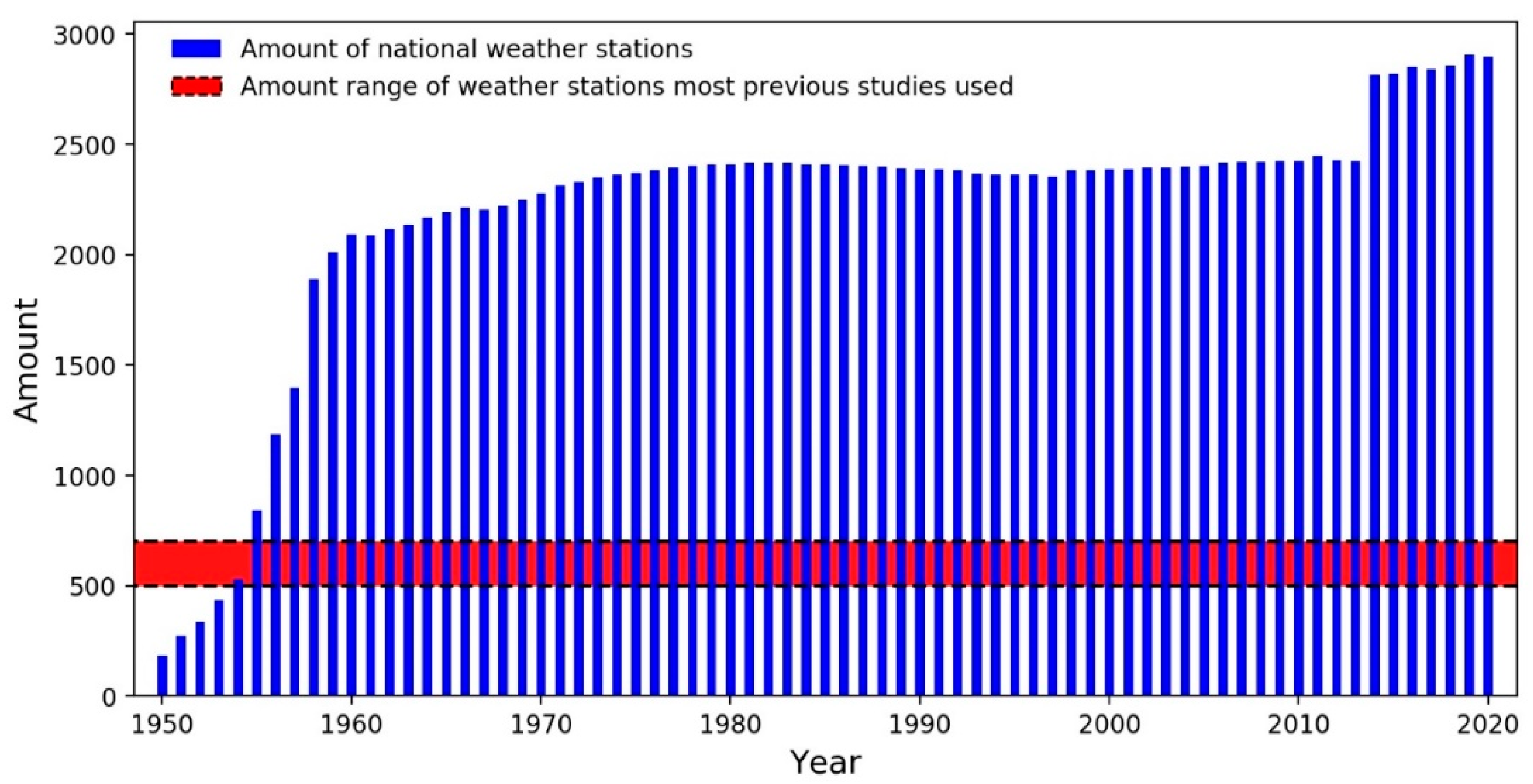
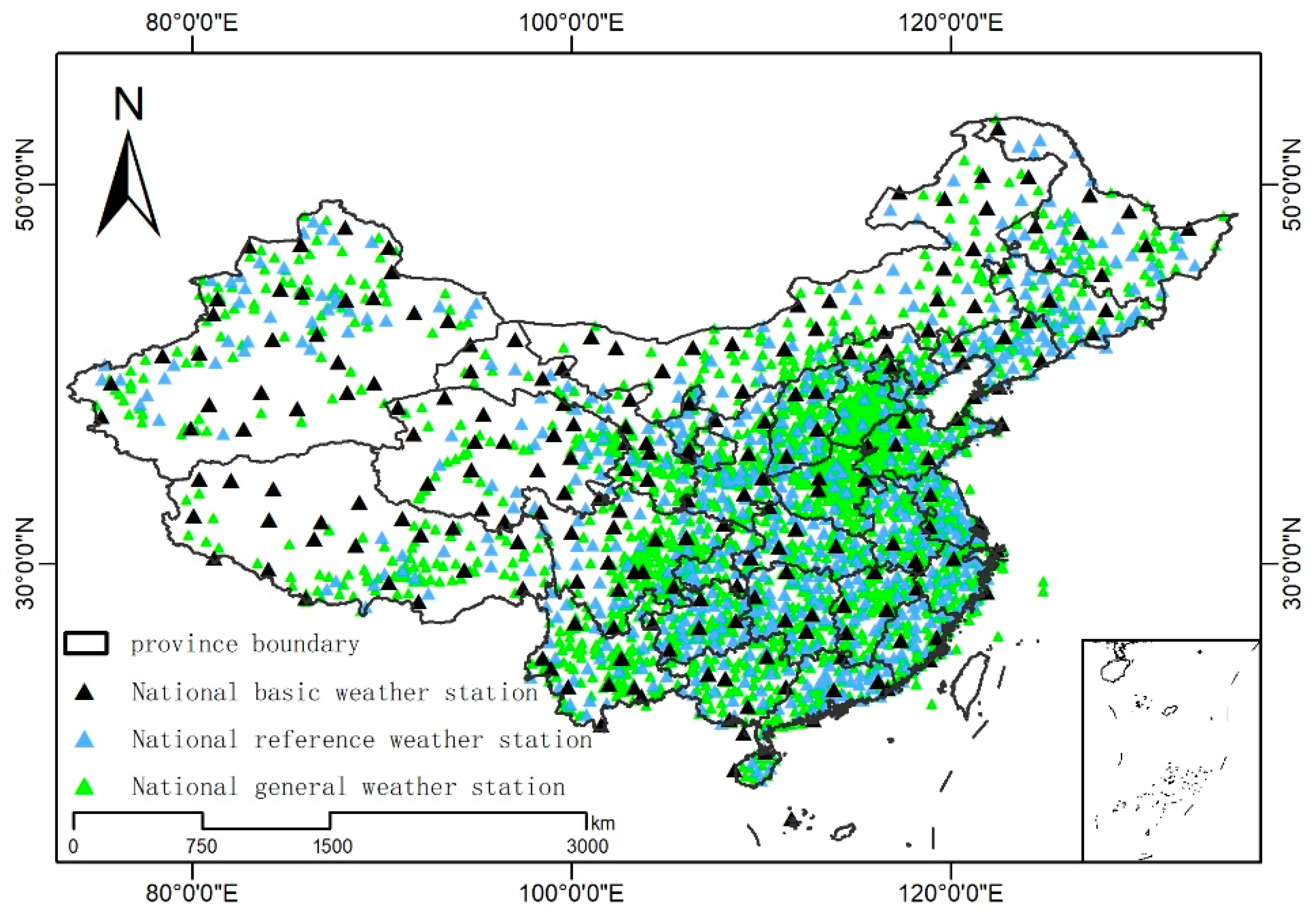
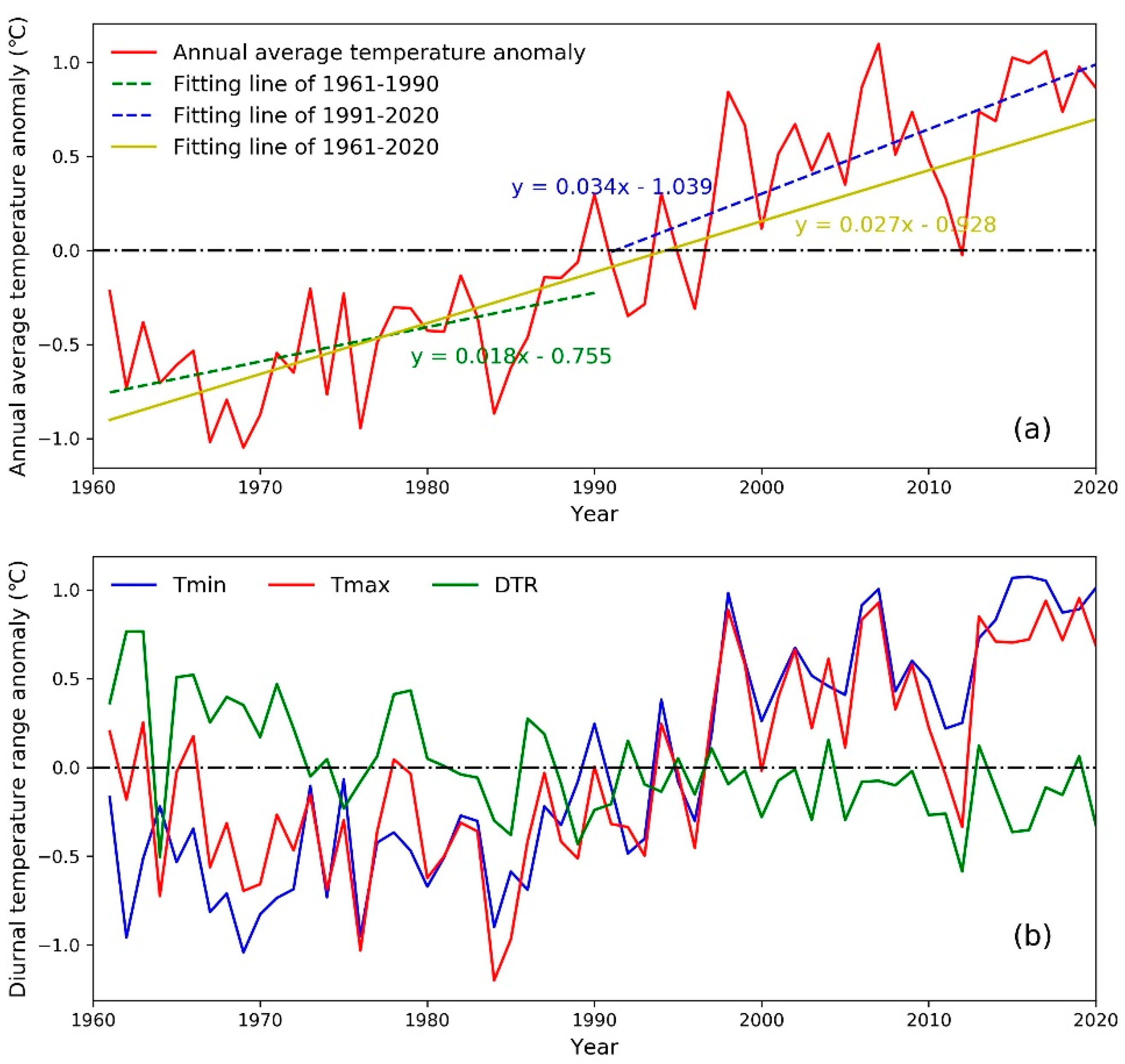
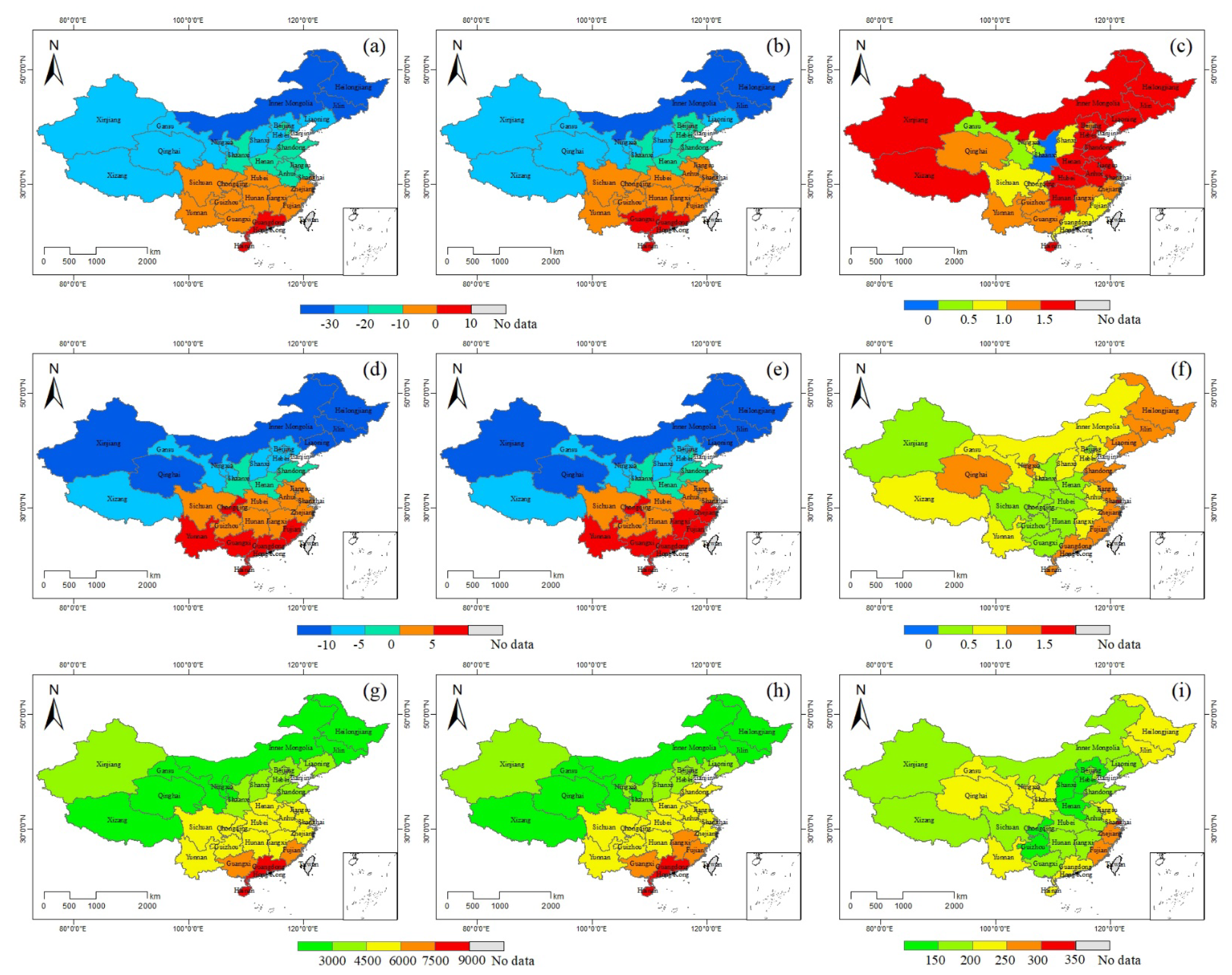
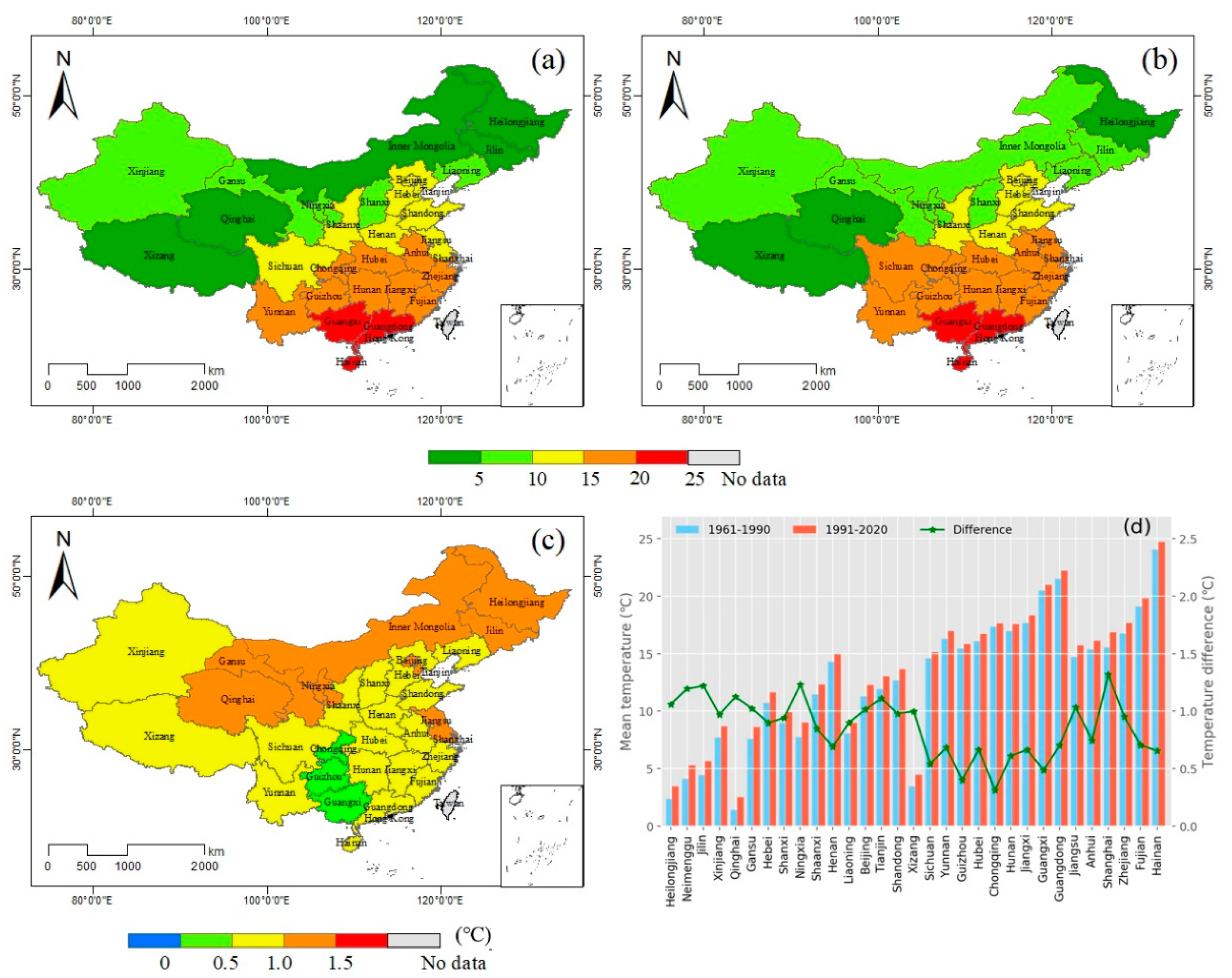
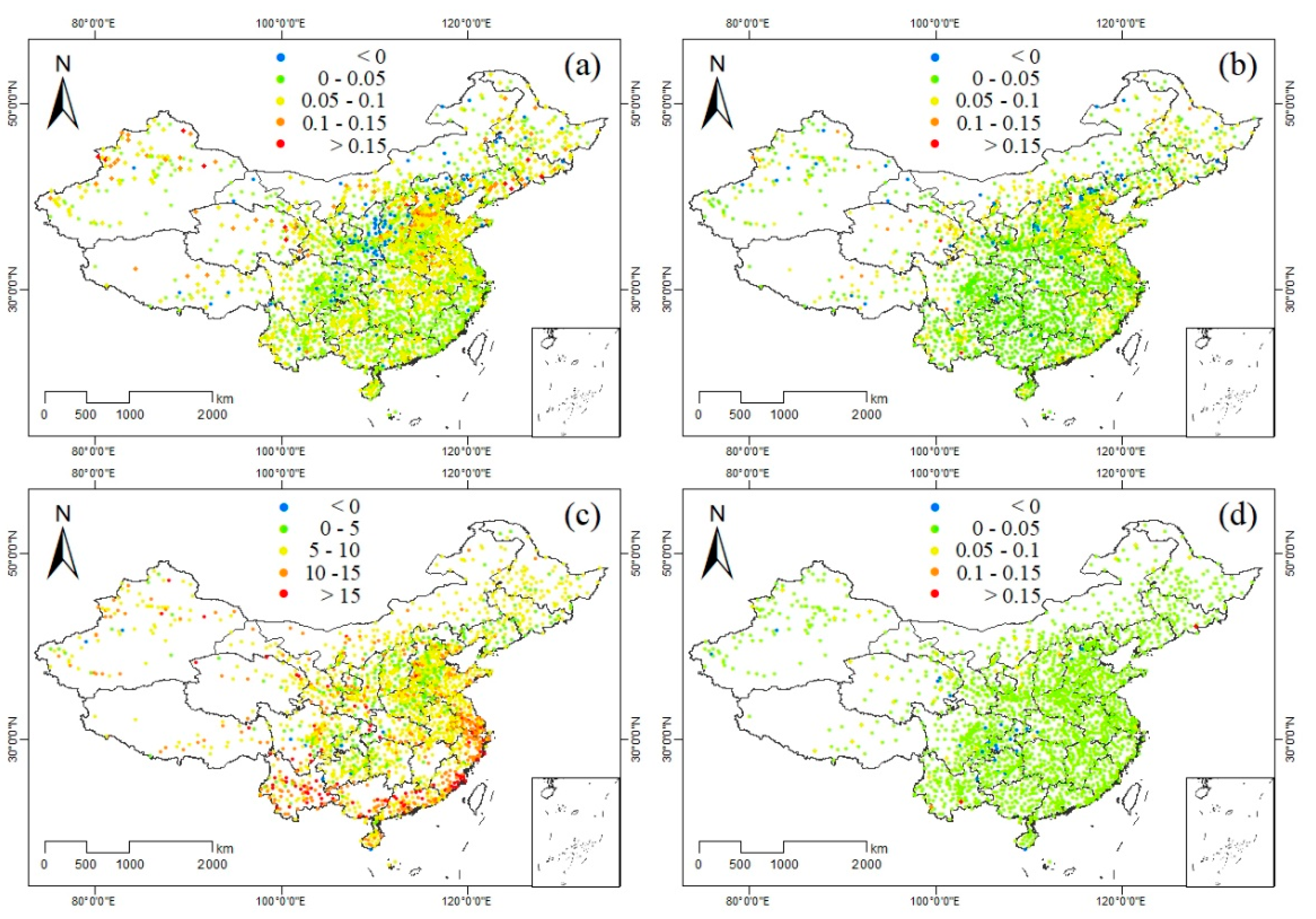
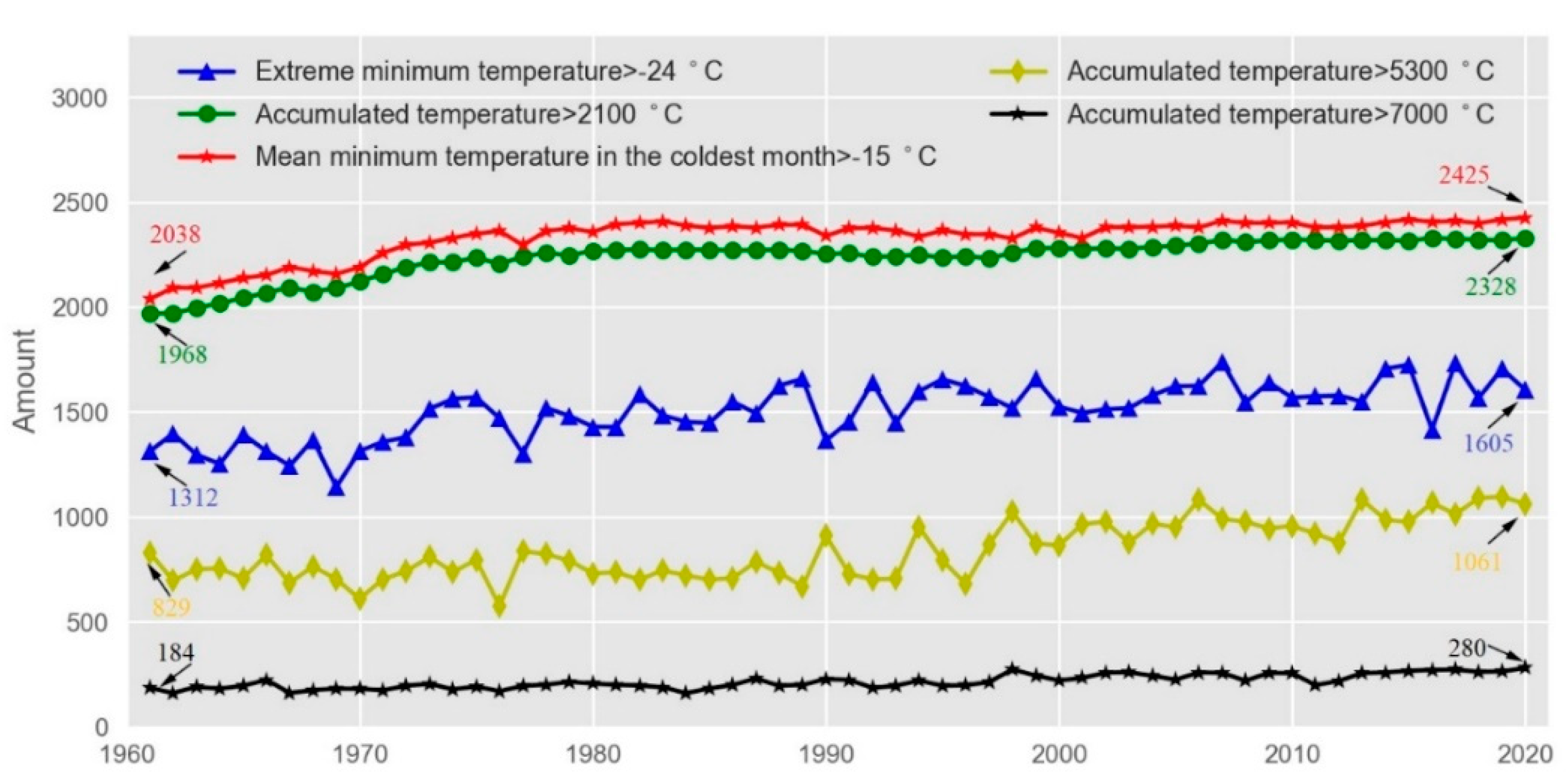
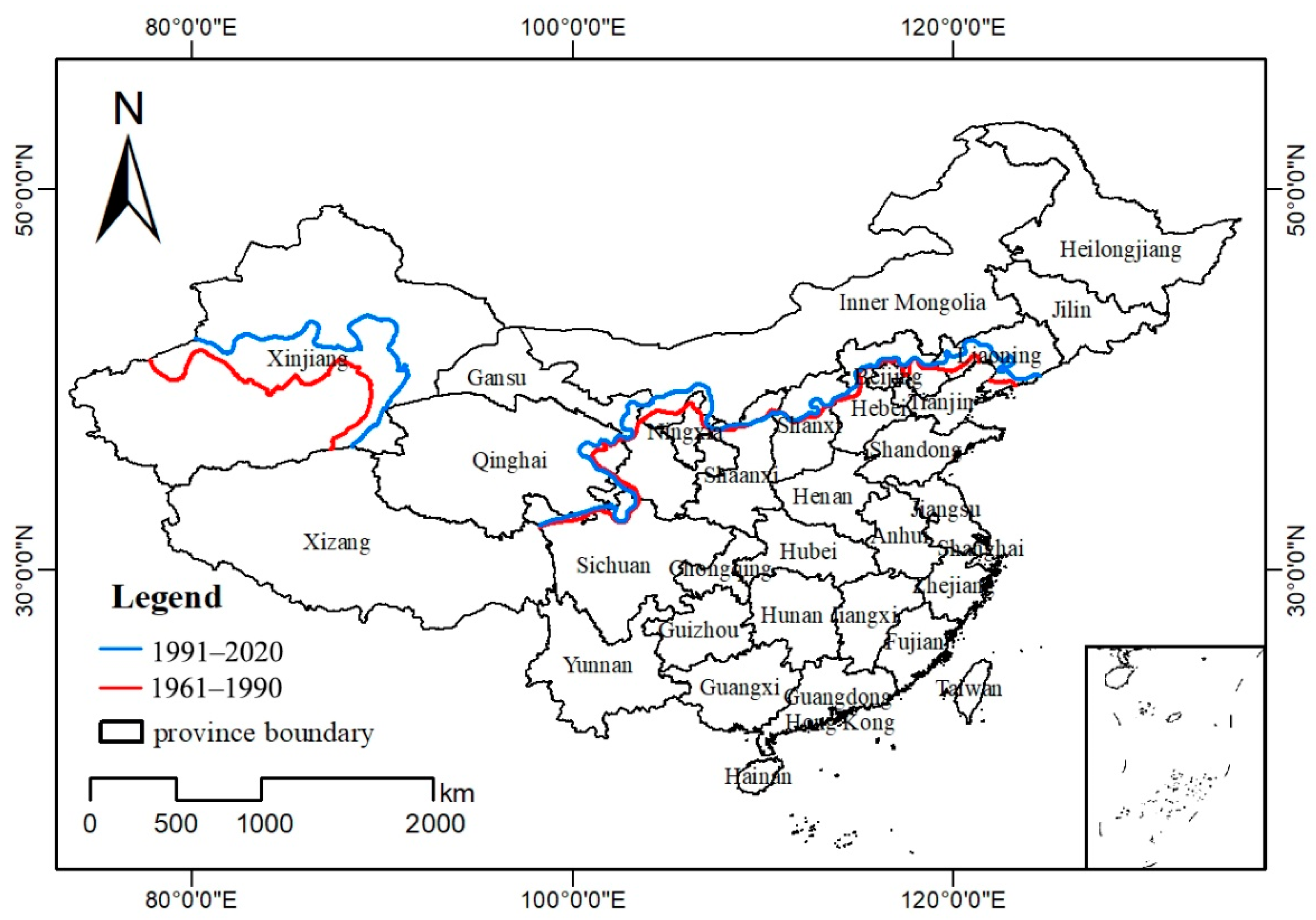
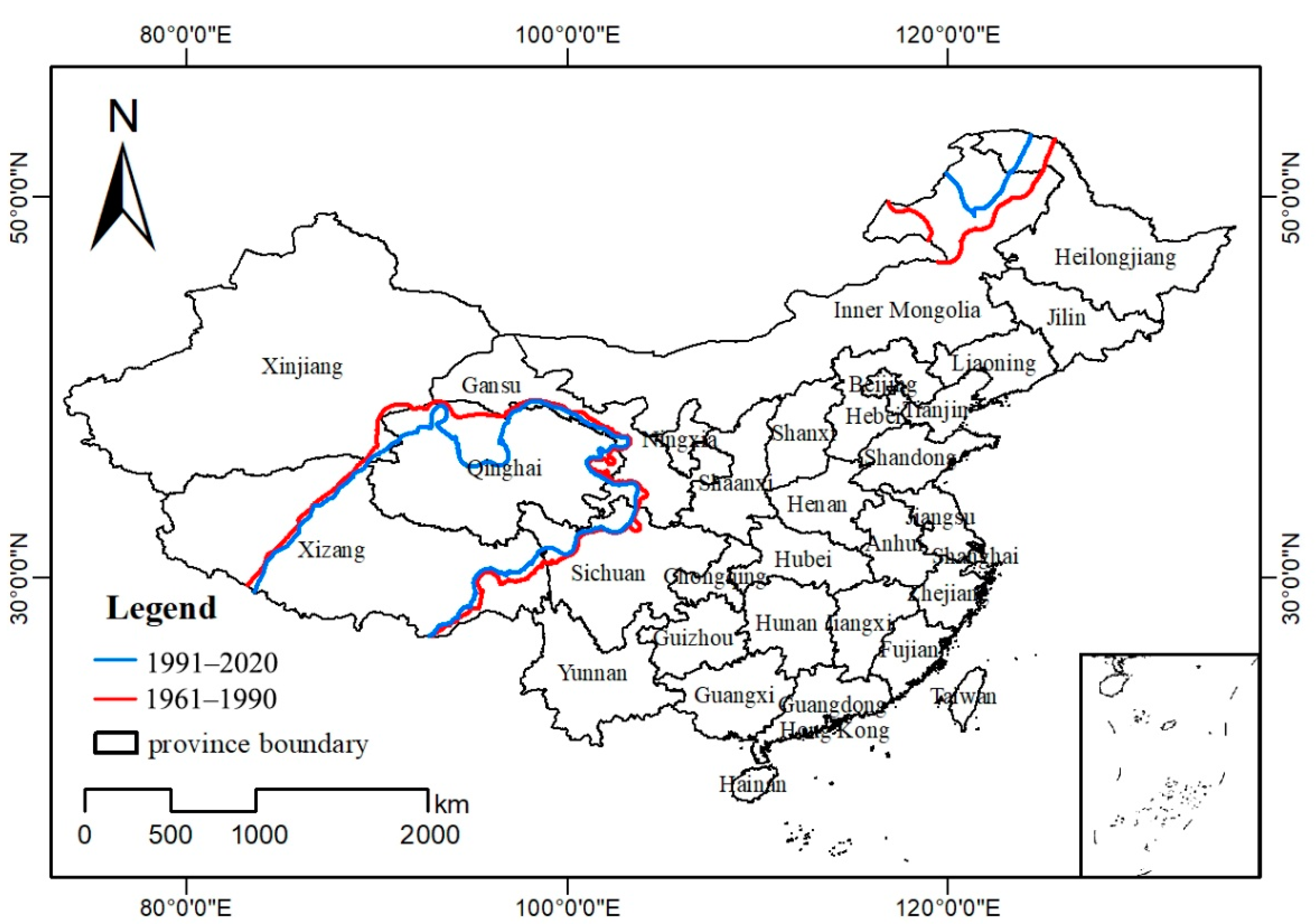
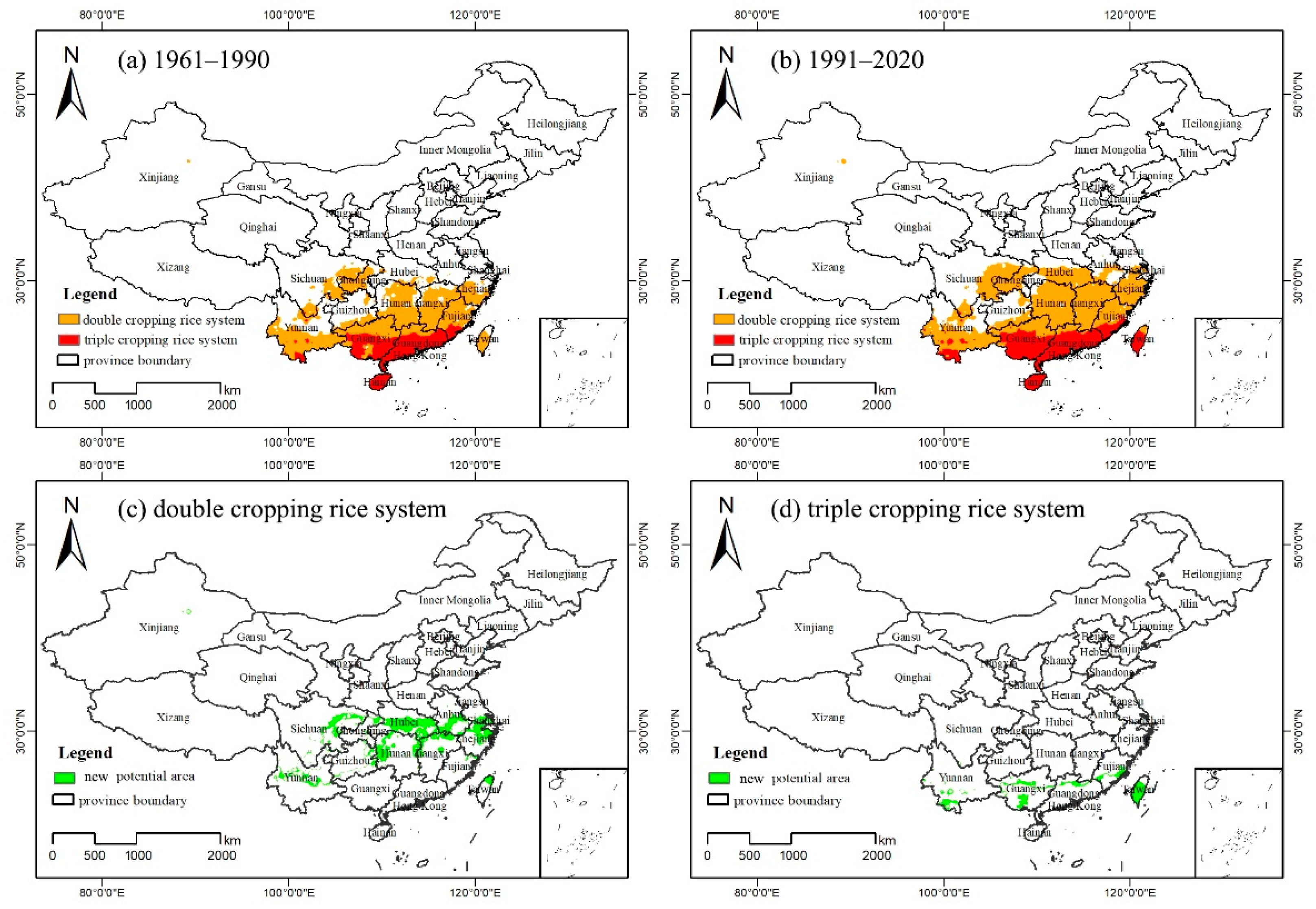
| Crop Type | Determination Index | Reference | |
|---|---|---|---|
| Winter wheat |
| [19,20,21] | |
| Spring maize |
| [22,23] | |
| Rice | Double cropping system |
| [24] |
| Triple cropping system | |||
Publisher’s Note: MDPI stays neutral with regard to jurisdictional claims in published maps and institutional affiliations. |
© 2022 by the authors. Licensee MDPI, Basel, Switzerland. This article is an open access article distributed under the terms and conditions of the Creative Commons Attribution (CC BY) license (https://creativecommons.org/licenses/by/4.0/).
Share and Cite
Zhuo, W.; Fang, S.; Ma, Y.; Zhang, R.; Wang, L.; Li, M.; Zhang, J.; Gao, X. Effects of Climate Warming on the Potential Northern Planting Boundaries of Three Main Grain Crops in China. Agriculture 2022, 12, 746. https://doi.org/10.3390/agriculture12060746
Zhuo W, Fang S, Ma Y, Zhang R, Wang L, Li M, Zhang J, Gao X. Effects of Climate Warming on the Potential Northern Planting Boundaries of Three Main Grain Crops in China. Agriculture. 2022; 12(6):746. https://doi.org/10.3390/agriculture12060746
Chicago/Turabian StyleZhuo, Wen, Shibo Fang, Yuping Ma, Rui Zhang, Lei Wang, Mengqian Li, Jiansu Zhang, and Xinran Gao. 2022. "Effects of Climate Warming on the Potential Northern Planting Boundaries of Three Main Grain Crops in China" Agriculture 12, no. 6: 746. https://doi.org/10.3390/agriculture12060746
APA StyleZhuo, W., Fang, S., Ma, Y., Zhang, R., Wang, L., Li, M., Zhang, J., & Gao, X. (2022). Effects of Climate Warming on the Potential Northern Planting Boundaries of Three Main Grain Crops in China. Agriculture, 12(6), 746. https://doi.org/10.3390/agriculture12060746







